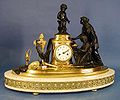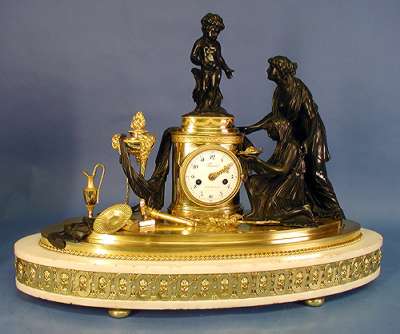Datei:Furet Pendule (1).jpg
Furet_Pendule_(1).jpg (400 × 334 Pixel, Dateigröße: 18 KB, MIME-Typ: image/jpeg)
Um 1785 French Ormolu and Patinated Mantel Clock, Furet a Paris. Attributed to Thomire, bronze caster, and Moitte, sculptor.
A very rare Louis XVI ormolu and patinated figural mantel clock signed by the clockmaker Furet Horologer du Roi, and attributed to the bronzer Pierre-Philipe Thomire and the sculptor Jean-Guillaume Moitte. In the center is a burnished ormolu alter that has engraved moldings and supports the patinated figure of Cupid who stands amongst swirling clouds. To one side are two patinated vestal virgins, the keepers of the eternal flame and servants of Vesta, making an offering. On the other side is the eternal flame that is supported on three curved legs that terminate in wonderfully cast rams heads above and hooves below. Scattered about the base are a pitcher and an assortment of Cupid's implements including his bow, quiver and shield. A patinated drapery that begins in the right hand of the standing virgin flows through the assorted mounts where it finally ends draped over the ormolu steps. The whole assembly sits upon an oval shaped white marble base which has a finely cast and detailed freeze across the front and stands on six bun feet. The white porcelain dial has extremely finely lettered black Arabic numbers for the hour's chapter, red numbers for the fifteen-minute markers, cast ormolu 'scissor' hands that unusually have not been clipped and is signed in red by the clockmaker Furet, Horologer du Roi. The twin-barrel eight-day movement strikes on a bell and still retains its original silk-thread suspension. The rarity of the piece is not the subject matter or iconography, but the way it is executed and the artists involved. The general quality is superior, from the castings to the finishing work, and is consistent with these masters. There is a spatial component to the scene that is very theatrical. It is a scene being played out on a stage. Such compositions were favored by the English maker Vulliamy whose designs were based on funeral statuary and of greater relevance the bronzer Thomire. There are several clocks that have been attributed to Thomire which contain the same elements as this clock. Two are listed in Vergoldete Bronzen, pages 298-299 including the one in the Getty museum. It is there that Moitte is given the attribute of sculptor. The clockmaker, Jean-Baptiste-Andre Furet was made clockmaker to the king in 1783. His clocks ranged from very high quality mantel pieces to the famous Negress clock made for Marie Antoinette. The clock is restored and complete. Height 16.5in. Width 22in.
Sundial Farm Antique Clocks Ltd.
Lizenz
Dateiversionen
Klicke auf einen Zeitpunkt, um diese Version zu laden.
| Version vom | Vorschaubild | Maße | Benutzer | Kommentar | |
|---|---|---|---|---|---|
| aktuell | 15:43, 24. Jan. 2012 |  | 400 × 334 (18 KB) | Andriessen (Diskussion | Beiträge) | Um 1785 French Ormolu and Patinated Mantel Clock, Furet a Paris. Attributed to Thomire, bronze caster, and Moitte, sculptor. A very rare Louis XVI ormolu and patinated figural mantel clock signed by the clockmaker Furet Horologer du Roi, and attributed |
Du kannst diese Datei nicht überschreiben.
Dateiverwendung
Die folgende Seite verwendet diese Datei:

